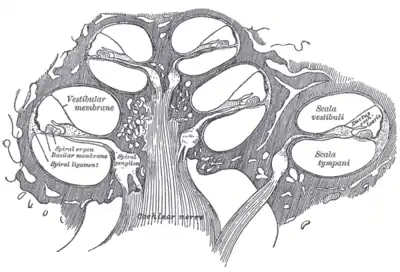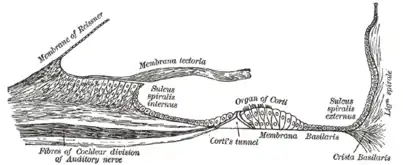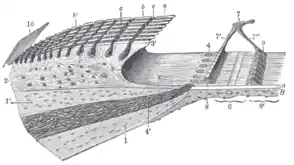Vestibular membrane
The vestibular membrane, vestibular wall or Reissner's membrane, is a membrane inside the cochlea of the inner ear. It separates the cochlear duct from the vestibular duct. It helps to transmit vibrations from fluid in the vestibular duct to the cochlear duct. Together with the basilar membrane, it creates a compartment in the cochlea filled with endolymph, which is important for the function of the spiral organ of Corti. It allows nutrients to travel from the perilymph to the endolymph of the membranous labyrinth. It may be damaged in Ménière's disease. It is named after the German anatomist Ernst Reissner.
| Vestibular membrane | |
|---|---|
 Cross-section of the cochlea showing the position of the vestibular membrane. | |
 Cross-section of the cochlea at higher magnification showing the membrane (here labelled "Reissner's membrane") | |
| Details | |
| Pronunciation | English: /ˈraɪsnər/ |
| System | Inner ear |
| Location | Cochlea of the inner ear |
| Identifiers | |
| Latin | membrana vestibularis ductus cochlearis |
| Anatomical terminology | |
Structure
The vestibular membrane separates the cochlear duct (scala media) from the vestibular duct (scala vestibuli).[1][2]
Microanatomy
Histologically, the membrane is composed of two layers of flattened epithelium.[3] These are separated by a basal lamina. Its structure suggests that its function is transport of fluid and electrolytes.
Function
The vestibular membrane helps to transmit vibrations from fluid in the vestibular duct to the cochlear duct.[4]
Together with the basilar membrane, the vestibular membrane creates a compartment in the cochlea filled with endolymph. This is important for the function of the spiral organ of Corti. It primarily functions as a diffusion barrier, allowing nutrients to travel from the perilymph to the endolymph of the membranous labyrinth.
Clinical significance
The vestibular membrane may be ruptured by an increase in the pressure of endolymph in the cochlear duct.[5] This may occur in Ménière's disease.[5]
History
The vestibular membrane is also known as Reissner's membrane.[3] This alternative name is named after German anatomist Ernst Reissner (1824-1878).
Additional images
 Floor of cochlear duct.
Floor of cochlear duct. Spiral limbus and basilar membrane.
Spiral limbus and basilar membrane.
References
- Javel, Eric (2003). "Auditory System, Peripheral". Encyclopedia of the Neurological Sciences. Academic Press. pp. 305–311. doi:10.1016/B0-12-226870-9/00529-3. ISBN 978-0-12-226870-0.
- Krey, Jocelyn F.; Gillespie, Peter G. (2012). "53 - Molecular Biology of Hearing and Balance". Basic Neurochemistry - Principles of Molecular, Cellular, and Medical Neurobiology (8th ed.). Academic Press. pp. 916–927. doi:10.1016/B978-0-12-374947-5.00053-5. ISBN 978-0-12-374947-5.
- Maynard, Robert Lewis; Downes, Noel (2019). "23 - The Ear". Anatomy and Histology of the Laboratory Rat in Toxicology and Biomedical Research. Academic Press. pp. 293–302. doi:10.1016/B978-0-12-811837-5.00023-X. ISBN 978-0-12-811837-5.
- Loftus, Brian D.; Athni, Sudhir S.; Cherches, Igor M. (2011). "2 - Clinical Neuroanatomy". Neurology Secrets (5th ed.). Mosby. pp. 18–54. doi:10.1016/B978-0-323-05712-7.00002-7. ISBN 978-0-323-05712-7.
- Hain, Timothy C. (2007). "12 - Cranial Nerve VIII: Vestibulocochlear System". Textbook of Clinical Neurology (3rd ed.). Saunders. pp. 199–215. doi:10.1016/B978-141603618-0.10012-8. ISBN 978-1-4160-3618-0.
External links
- Histology at KUMC eye_ear-ear03
- UIUC Histology Subject 76
- Overview at University of Wisconsin–Madison
- Image at University of New England, Maine